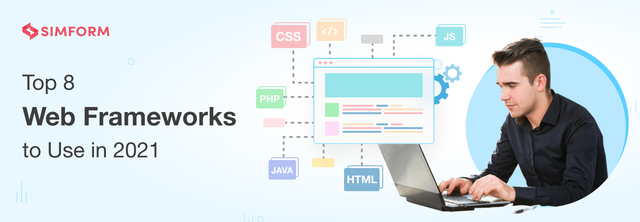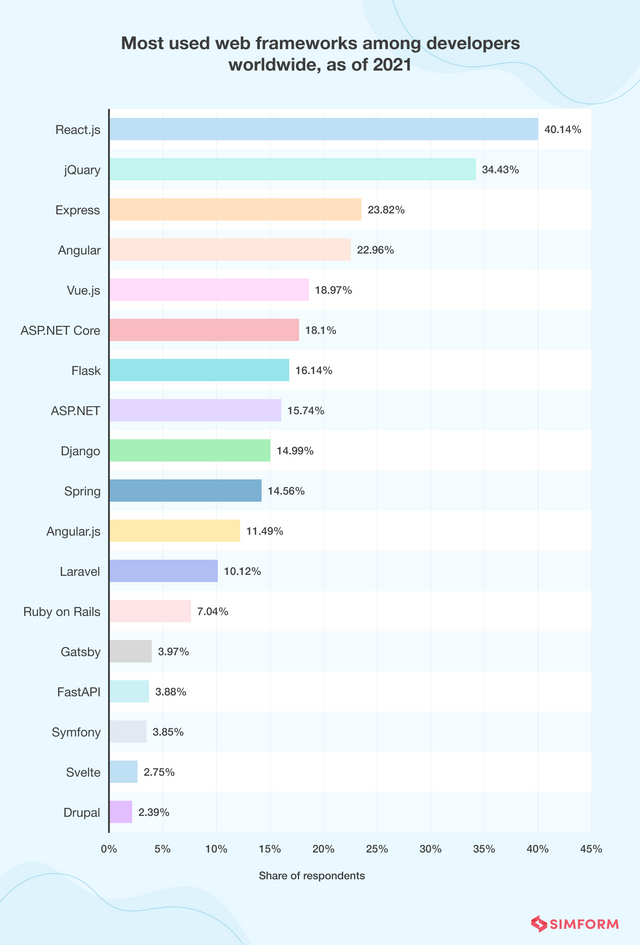Top 8 Most Popular Web Frameworks to Use in 2021

Web frameworks play a vital role in building robust and interactive web applications for both frontend and backend. If we were to talk about some of the most popular web applications, the prominent names would be Netflix, Facebook, LinkedIn, and YouTube. These tech giants have set an example of how web apps should be built.
Companies wanting to achieve such magnanimous success often end up replicating the entire tech stack of these tech giants. However, one must note that what works for them might not work for you. And that every web app framework isn’t suitable for all kinds of use cases.
List of Web Frameworks Based on the Popularity

React
React was released by Facebook in 2013, and in no time, it became popular among developers and enterprises. It is a JavaScript library that can be used to build interactive user interfaces that are enough to lure any developer and business into picking React as their frontend framework for web app development. Simform has also utilized the component-driven React framework for one of our projects, FIH, to build the frontend to deliver an excellent user experience and ensure flexibility.
jQuery
jQuery is one of the oldest players in the race, which is still embracing the opportunity of being loved by the majority of developers. More than 41 million websites are using jQuery alone in the United States. Apart from this, 82.64% of websites among the top 10K websites are also earning profits using jQuery for their web applications.
Express.js
Express.js is a lightweight and fast server-side framework based on Node.js, introduced to develop backend web applications and APIs. Since its release, it’s rising in popularity due to its robust features and minimalistic functionality. Apart from this, it’s being utilized by millions of web development firms for developing highly scalable enterprise apps and APIs. Simform has also used this framework to create the backend of a sentiment-based real-time market analytics engine named SentMap.
Angular
Angular is another open-source JavaScript framework that is dominating the list of web frameworks that exist today. Google introduced Angular.js in 2010 and then rewrote it from scratch and released it in 2016 as Angular 2 (a.k.a. Angular) to build high-performance and large-scale JavaScript-based web apps. Unarguably, it’s a mature framework to create SPAs and web pages for mobile and desktop platforms.
Vue.js
It was introduced in 2014 as the best alternative to Angular and React for building SPAs and creating visually appealing user interfaces. It’s a progressive JavaScript framework that has combined the excellent traits of Angular (View Layer) and React.js (Virtual DOM). It made sure that Vue gained traction in no time. As a result, this is one of the most popular frameworks used widely for building responsive web applications.
Flask
Flask is a WSGI framework written in Python that runs on a web server instead of the user’s browser. It is categorized as a microframework as it doesn’t require tools and libraries by default. The database abstraction layer, form validation, and components are also not available in this framework. It doesn’t mean that Flask is lacking in functionality. It is intended to keep the core simple but extensible. After all, it supports extensions by letting developers add libraries and plugins to web apps like it was implemented in this framework. It’s a highly lightweight framework, which is gradually climbing the charts and gaining attention due to its flexibility.
Django
Django is another Python-based framework that is winning the hearts of developers and enterprises for building highly scalable web applications. From news sites to social networking web apps, this framework can work well with any client-side requirement. This framework can be used in any format such as HTML, JSON, and XML. It is a high-level Python framework, which developers like for its pragmatic and clean design.
ASP.NET Core
This advanced version of ASP.NET is luring enterprises and developers worldwide with its flexible, scalable, and high-performance features. A Core version was introduced in 2016 as an open-source and modular framework to modernize and innovate its old tech stack ASP.NET in order to meet modern web development needs. Since then, this web framework is gaining immense popularity for creating high-performance, secure, and modern web applications. Furthermore, it can work seamlessly with JavaScript-based client-side frameworks.
In a Nutshell
Now you know about the eight web application frameworks that are in demand among developers and businesses. Unarguably, JavaScript frameworks are dominating the market with their excellent features and rich functionalities. However, Python frameworks are also leading the market with their advanced functionalities and fast development.
Originally published at Simform: Top 8 Most Popular Web Frameworks to Use in 2021